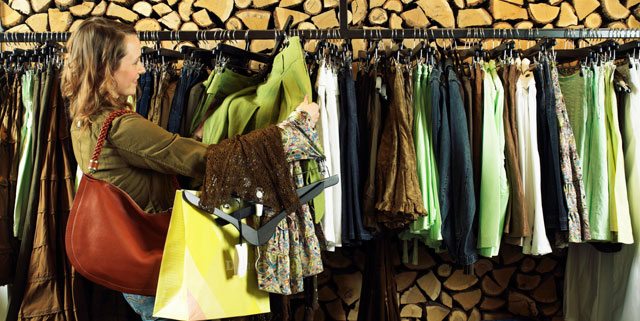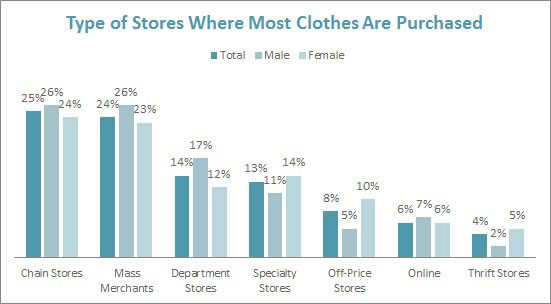A specialty grocery store in Australia made headlines around the world when it began charging a $5 fee for simply browsing. But experts say this reaction to showrooming – researching a product in-store before buying it elsewhere – could backfire.
Boston Retail Partners’ Perry Kramer, vice president, says retailers need to adapt.
[quote]”They need to execute better on their differentiators — price, quality, customer service, fashion — to remind customers what makes them unique, instead of pushing them away for showrooming,” Kramer says. “And if the person browsing online is a frequent in-store or multi-channel shopper, provide them with coupons, reward points or other offers that cross channels.”
While online clothes shopping continues to grow, most consumers still buy the bulk of their apparel in stores. A quarter of consumers (25%) shop for most of their clothing at chain stores, according to the Cotton Incorporated Lifestyle Monitor™ Survey. This is followed by mass merchants (24%), department stores (14%), specialty stores (13%), off pricers (8%) and online (6%). Consumers certainly browse for apparel online; nearly half of all consumers (48%) browse the Internet for clothes on their mobile or smart phone, and 22% buy apparel through their mobile device.
The fear that consumers are using their phones and notebooks to shop price is spurring the “race to the bottom” retail conversation. But Revionics’ Kathy Beck, senior director for the retail consultancy, says that is not a solution.
“Amazon and Walmart can win at that, but very few can play the ‘lowest price’ game,” Beck says. “However, employing in a ‘just looking’ charge could be very damaging, potentially preventing a shopper from even entering the store.”
Instead, Beck underscores the importance of engagement.
“We are living in a time where shopper engagement, and surprising and delighting the shopper in order to drive loyalty, is the only way to avoid the downward spiral of price competition and hyper-promotional activity. The shopping experience is a key differentiator that retailers can use to move that omni-channel, digital shopper away from thinking price is the most important decision factor. They can make the in-store experience so special and gratifying it trumps the convenience of online purchasing.”
Right now, 51% of consumers “like or love” clothes shopping, the Monitor finds. More than 7 of 10 (71%) peruse the Internet for apparel, up from 66% in 2011. And they spend about 105 minutes each month browsing online. Yet, they shop in stores about twice per month, compared to once a month online, according to the Monitor.
Industry experts agree that the key to avoiding price matching is by engaging the consumer and creating loyalty to the store — not just to the discounts.
Swift Exchange is a new e-commerce currency firm that is looking to help stores increase consumer loyalty via a high-tech platform. The program, targeted to launch later this year, will allow consumers who have reward points with multiple stores and credit cards — say, Delta, Chase and Best Buy — to combine those points and use them like cash at participating merchants, from large chains to mom-and-pop apparel stores.
“Let’s say a dress is selling for less down the street or on the other side of the mall,” explains Rob Jacobson, chief creative officer. “This program will cut down on showrooming because reward points will allow shoppers to stay, use points instead of cash, and avoid the hassle of going elsewhere. It will get participating merchants away from the price matching competition, and help cement customer loyalty.”
Beck says stores could also drive customer loyalty with retail’s four Ps: product, price, place and promotion.
“Retail got away from that for a long time,” Beck says. “But now competition is fierce and companies are going out of business. Shoppers are empowered, so you have to do everything to understand them — and use every tool available to get to them.”
Now may be an especially be a good time for retailers to look beyond deals and price matching. Nearly half of all consumers (48%) are “very or somewhat optimistic” about their personal financial situation, the Monitor shows, an increase from 46% in 2011. Even if consumers choose to use their phones to comparison shop, retailers can benefit if they recognize most people only have a finite amount of time and energy to devote to clothes shopping. Some consumers may want a good price (59%), but more important to the purchase are clothes that fit (77%) and are comfortable (68%).
“Retailers need to maintain focus on training their associates on product knowledge and sales techniques,” Kramer says. “If a store associates experiences a person showrooming for one product, they should show them matching items. Make the customer a deal and make it hard for them to leave empty-handed. Especially in fashion, customers rarely have a single-item shopping experience.”
As for the $5 “just looking” charge?
“How you could determine if a person was showrooming or just texting the babysitter or a friend?” Kramer points out. “Shopping in stores is still very much about the fun and experience. Trying to pull a smartphone out of the customers’ hands is a great way to ruin that.”

